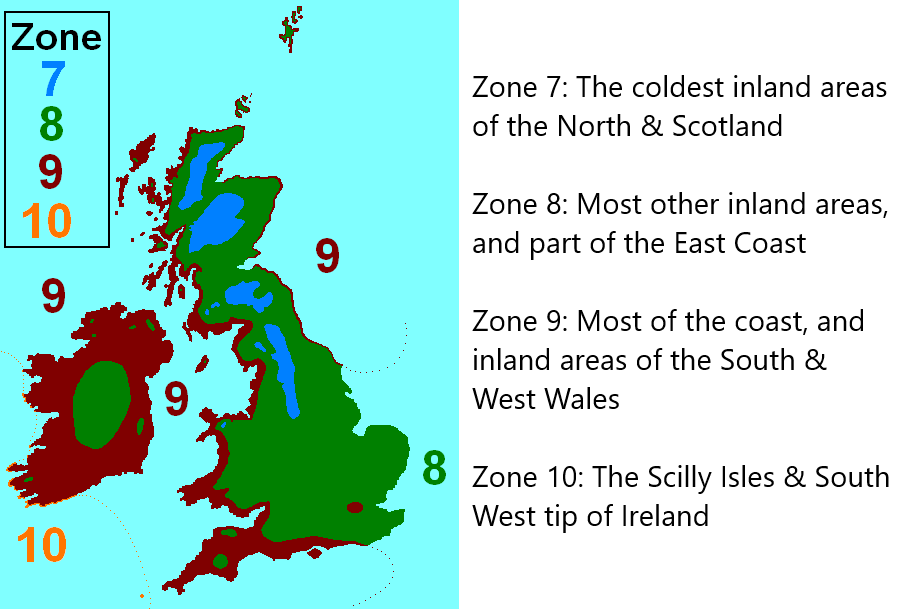“Where am I, and whose garden is this?” is a common question among cider drinkers and other fun people, and it’s pretty relevant to how your garden works
Great Britain has one “temperate oceanic / maritime” climate and isn’t very big, but she is still varied enough that it helps to know where your garden stands in terms of how cold it gets in Winter.
Plant Hardiness Zones, garden zones for short, are areas with minimum winter temperatures within a certain band.
This helps you to choose the right plants, and to know if a plant is too tender to grow normally outside in your beds.
- Find your USDA garden zone using this interactive map
- Compare your USDA zone to the RHS Hardiness Rating in the table below
- Look up the plants that interest you in the RHS Plant Finder to see their Hardiness Rating.
- Most likely, you are in USDA 8b/9a, where plants rated by the RHS as H4 and above should be fine outdoors, and plants rated H3 might be OK if they are sheltered, near a warm house and sunny wall that keeps the worst of the frost away.
- If you’re on the coast or in the South West, you are probably in the warmer USDA 9b zone, where plants rated by the RHS as H3 and above should be fine outdoors, and plants rated H2 might be OK if they are sheltered, against a warm house and sunny wall that keeps any frost away.
- Remember that plants growing in pots are more exposed than those in the soil, so they might lose a hardiness rating point.
| USDA Zone |
RHS Rating |
Min. Winter Temp. range ºC (ºF) |
Category | Definition |
|---|---|---|---|---|
| 6a-1 | H7 | below -20C (< -4F) |
Very hardy | Hardy in the severest European climates, including exposed upland locations. |
| 6b/7a | H6 | -20 to -15C (-4 to 5F) |
Hardy: very cold winter | Hardy throughout Northern Europe. Plants grown in containers may still need protection. |
| 7b/8a | H5 | -15 to -10C (5 to 14F) |
Hardy: cold winter | Hardy through most of the UK even in severe winters. May not withstand open or exposed sites or central / northerly locations. Many evergreens suffer foliage damage. (Many herbaceous & woody plants, some brassicas, leeks.) |
| 8b/9a | H4 | -10 to -5C (14 to 23F) |
Hardy: average winter | Hardy except in inland valleys, at altitude, and central / northerly locations. May suffer foliage damage and stem dieback in harsh Winters & frost pockets. Some normally hardy plants may not survive long wet winters in heavy or poorly drained soil e.g Lavender. (Many herbaceous & woody plants, winter brassicas, leeks.) |
| 9b/10a | H3 | -5 to 1C (23 to 34F) |
Half-hardy: unheated glasshouse / mild winter | Hardy in coastal / mild areas except in hard Winters, when it may be damaged / killed, particularly with no snow cover or if pot grown. At risk from early frosts. May be hardy elsewhere with wall shelter or good microclimate. Can survive with artificial winter protection. (Many Mediterranean plants, spring sown vegetables for later harvesting). |
| 10b | H2 | 1 to 5C (34 to 41F) |
Tender: cool or frost-free glasshouse | Tolerates low temperatures, but not being frozen. Needs glasshouse conditions in Winter until the last frost has passed. Might overwinter outside in frost-free inner-city areas or coastal extremities (Most succulents, many subtropical plants, annual bedding plants, many springsown vegetables.) |
| 11 | H1c | 5 to 10C (41 to 50F) |
Heated glasshouse: warm temperate | Grows outdoors in Summer in most areas, while daytime temperatures are sufficient for growth. (Most bedding plants, tomatoes and cucumbers.) |
| 12 | H1b | 10 to 15C (50 to 59F) |
Heated glasshouse: subtropical | Can grow outdoors in Summer if sunny & sheltered. Generally best indoors, or under glass year round. |
| 13 | H1a | above 15C (>59F) |
Heated glasshouse: tropical | Grown indoors, or under glass year round. |
There are two main differences between the USDA hardiness zone and the RHS hardiness rating approach:
- The USDA zone system is based on average minimum winter temperatures. The RHS rating system prefers to look at maximum minimum winter temperatures.
- The USDA zone system is focussed on the location and its temperature. The RHS rating system is focussed on the plant and its requirements.
Well seasoned and sober readers will recall life before 2011, when the RHS had only 4 hardiness categories. That simply wouldn’t do, so it was updated in favour of the above table.
As this pdf article on the change notes, “a plant’s survival and success depends upon many other factors [than minimum Winter temperature]: climatic, edaphic (soil), cultural and genetic.”
So your garden zone, meaning your minimum Winter temperature, is only one important factor in whether a plant will thrive or not.
As you might expect, a strong, healthy plant is likely to tolerate slightly lower temperatures, and vice versa a weak, unhappy plant might die in Winters that should not kill it according to the table above.
Looking at the 2006 USDA garden zone system map for the UK, which is close enough for government work, using the basic numbers 7-10 (each number is a 10 degree band, normally split in half into 5 degree increments, marked as a/b), we see that almost everyone in the UK is in USDA zone 8 or 9.
On the coast you’re a 9, but everywhere else except London you’re an 8, pretty much unless you live in the Grampian mountains.

